In a world where information bombards users from every angle, news platforms must stand out to capture attention and build loyalty. AI is revolutionizing this challenge, transforming how audiences interact with news through personalized, accessible, and engaging experiences. By leveraging AI in news platforms, product leaders can create seamless, user-centric solutions that turn casual readers into devoted followers. This exploration dives into the intelligent features—summarization, translation, personalization, and more—driving the next era of news engagement.
Practical use cases of AI in news platforms
Embracing AI unlocks innovative ways to engage audiences, streamline content delivery, and enhance user experiences across global news platforms. Below are key features that redefine how users connect with news content:
Streamlining content with AI summarization
Value for users: AI summarization is a game-changer in terms of time management for consumers. In today’s fast-paced world, keeping up with the sheer volume of news is challenging. Summaries allow users to quickly grasp the main points of an article during a commute, a coffee break, or while multitasking. They can stay informed on a broader range of topics without committing to reading lengthy articles. This is particularly beneficial for staying updated on breaking news or deciding whether a particular article warrants a deeper read.
Impact on platform engagement: By offering concise summaries, news platforms cater to users with limited time, reducing the barrier to entry for engaging with their content. AI summarization enables users, especially those with limited time or unfamiliar with a topic, to quickly grasp an article’s essence, increasing click-through rates and platform traffic. Furthermore, users who appreciate the efficiency of summarization are more likely to return to the platform regularly, fostering loyalty and increasing session duration as they navigate through more summarized content.
How AI works: Natural Language Processing (NLP) algorithms, often leveraging techniques like extractive and abstractive summarization, are at play here. Extractive summarization identifies and extracts the most important sentences or phrases directly from the original text to form a concise summary. On the other hand, Abstractive summarization goes a step further by understanding the context and generating new sentences that capture the article’s essence, similar to how a human would summarize. These algorithms analyze the text’s structure, identify key entities, understand relationships between them, and condense the information while maintaining coherence and accuracy.
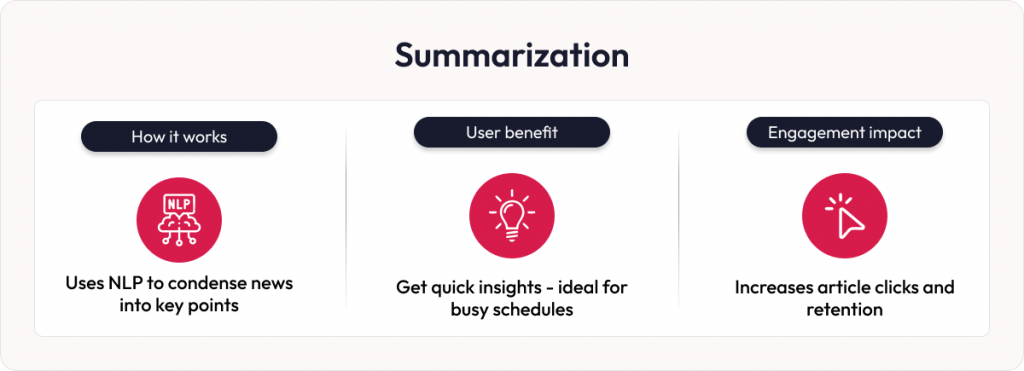
Expanding access with AI translation
Value for users: AI translation enhances accessibility to global news, including video content with real-time subtitles or dubbing for international audiences. Consumers can effortlessly access news from international and localized sources, such as regional content in diverse markets like India, in their preferred language. breaking down geographical and linguistic barriers. This opens up a world of diverse perspectives and allows for a more comprehensive understanding of global events. For individuals who are not fluent in the language in which a news story is published initially, AI translation is an invaluable tool for staying informed and connected with the world.
Impact on platform engagement: By offering multilingual content, news platforms can significantly expand their reach to a global audience. This increased accessibility can attract new users who were previously unable to engage with the platform due to language limitations. Offering content in multiple languages also caters to the preferences of existing users who may prefer to read news in their native language, leading to increased time spent on the platform and higher user satisfaction. This broader reach and improved user experience directly contribute to increased engagement metrics.
How AI works: AI translation relies on sophisticated Machine Translation (MT) models, often based on Neural Machine Translation (NMT) architectures. These models are trained on massive multilingual datasets, enabling them to learn the nuances of different languages, including grammar, syntax, and even idiomatic expressions. When a user requests a translation, the AI model analyzes the source text and generates an equivalent version in the target language. Advanced models also incorporate contextual understanding to produce more accurate and natural-sounding translations.
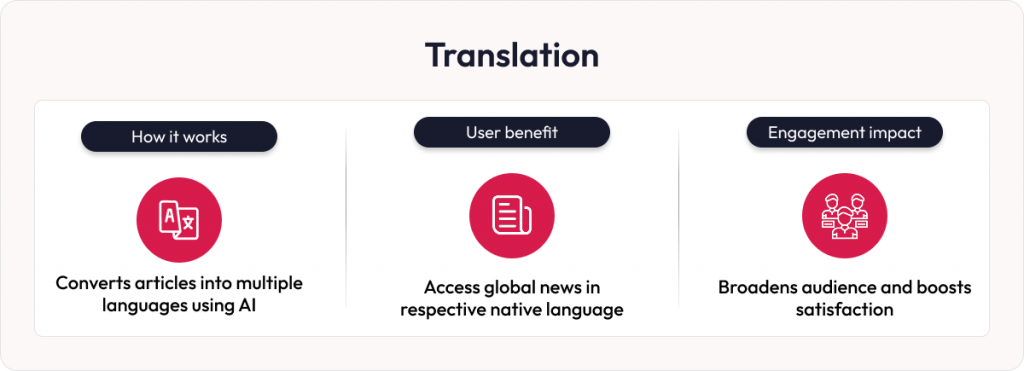
Curating experiences with AI personalization
Value for users: Personalized news feeds streamline the user experience by prioritizing stories that align with individual interests, powered by innovative OTT solutions. This reduces information overload, saving time and eliminating the need to sift through irrelevant content. A curated feed feels intuitive, delivering a seamless flow of news that resonates with users’ passions and concerns, fostering a deeper connection to the platform.
Impact on platform engagement: A highly relevant news feed drives user engagement by increasing clicks, extending session durations, and reducing bounce rates. Users who feel the platform understands their preferences are more likely to return, fostering loyalty and building a sense of community. Personalization transforms casual readers into devoted followers, strengthening the platform’s role in their daily lives.
How AI works: AI personalization engines create a tailored news experience by analyzing user data, such as browsing history, reading patterns, time spent on articles, interactions (likes, shares, comments), and demographic information (if available). Machine learning algorithms, including collaborative filtering and content-based filtering, identify user preferences and curate a customized news feed. These systems continuously adapt to evolving interests, ensuring the feed remains relevant and engaging over time.

Enhancing discovery with AI recommendations
Value for users: AI recommendations act as an intelligent guide, surfacing niche or hidden content that aligns with users’ interests, delivered seamlessly across platforms using a single codebase for OTT apps. This broadens horizons, exposes users to diverse perspectives, and introduces topics they might not have discovered independently. By uncovering “hidden gems,” recommendations make news exploration engaging and serendipitous.
Impact on platform engagement: Recommendations drive deeper platform exploration by increasing page views and time spent on site. Suggesting relevant or older articles enhances the value of the platform’s content library, while niche recommendations keep users engaged longer. Shareable suggestions also boost social media interactions, attracting new users and amplifying the platform’s reach.
How AI works: AI recommendation systems suggest specific articles, videos, or topics by analyzing user behavior and content characteristics. Using techniques like collaborative filtering (identifying similar user patterns) and content-based filtering (matching content to past interactions), these systems propose relevant items. Hybrid approaches combine both for greater accuracy and diversity. Recommendations continuously refine based on user feedback (clicks, reads, ratings), excelling at uncovering content users might not actively seek.
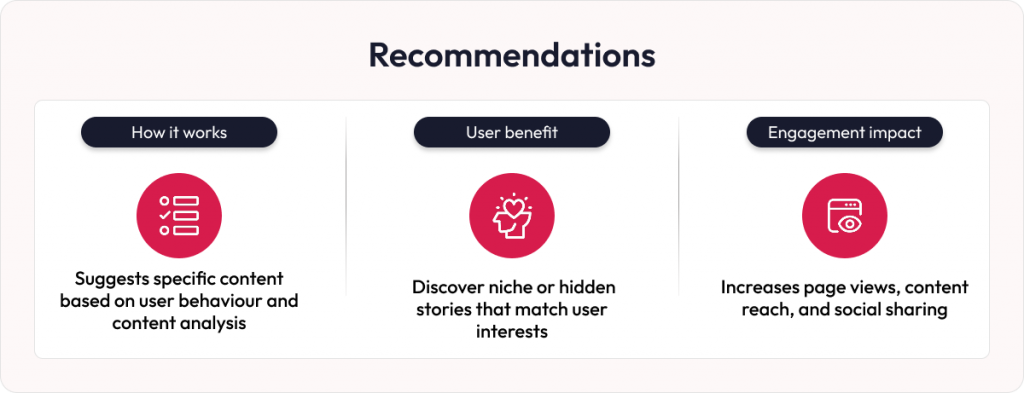
Supporting users with AI chatbots
Value for users: AI chatbots offer instant and convenient support for users. They can quickly answer frequently asked questions about subscriptions and account settings or provide information on specific news topics without the need to navigate through multiple pages or wait for human customer service. This immediate assistance enhances user experience and makes it easier for users to find the information they need, leading to greater satisfaction with the platform.
Impact on platform engagement: By providing quick and efficient support, AI chatbots can improve user satisfaction and reduce frustration, making users more likely to stay engaged. They can also guide users towards relevant content, increasing page views and time spent on the site. Additionally, chatbots can handle many queries simultaneously, freeing up human customer service resources to focus on more complex issues. This improved efficiency and user support contribute to a more positive and engaging user experience.
How AI works: AI chatbots utilize Natural Language Understanding (NLU) to comprehend user queries expressed in natural language. They are trained on vast datasets of questions and answers related to the news platform’s content, policies, and general information. When a user asks a question, the chatbot analyzes the intent behind the query and retrieves the most relevant information or guides the user to the appropriate resources. More advanced chatbots, powered by the rise of AI agents, can even handle more complex conversations and provide personalized assistance.
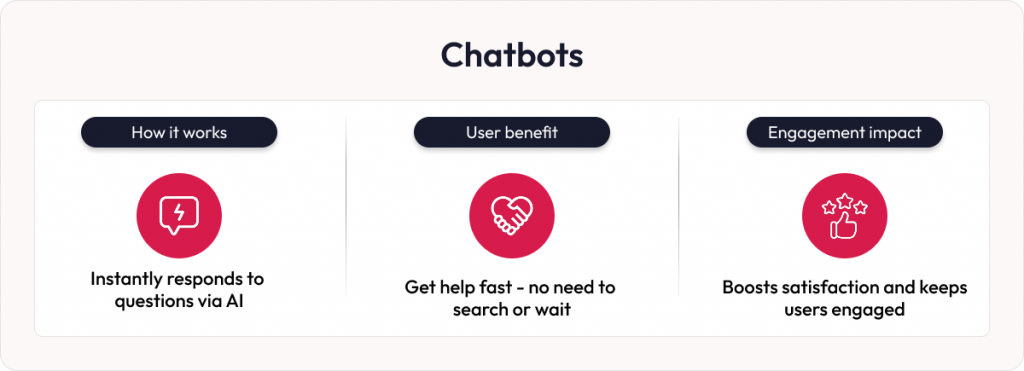
Refining search with AI technology
Value for users: AI-enhanced search makes finding specific information in a news platform’s vast archives significantly easier and faster. Instead of being overwhelmed by irrelevant results, users can quickly locate the articles, videos, or other content they seek, even if they don’t remember the exact keywords. This improved search experience saves time and frustration, making it more likely for users to delve deeper into topics of interest and find the information they need.
Impact on platform engagement: When users can easily find the information they seek, they are more likely to remain engaged with the platform. A frustrating search experience can lead to users abandoning the site. AI-powered search improves user satisfaction and encourages exploration of the platform’s content library. Delivering relevant results quickly increases the likelihood that users will find what they need and continue to engage with the platform’s offerings.
How AI works: AI-powered search goes beyond simple keyword matching by employing semantic search and natural language processing techniques. Semantic search understands the meaning and context behind user queries, even if the exact keywords are not in the documents. NLP helps the search engine analyze the grammatical structure and relationships between words, leading to more relevant results. AI can also incorporate personalization into search, prioritizing results based on a user’s past interactions and interests.
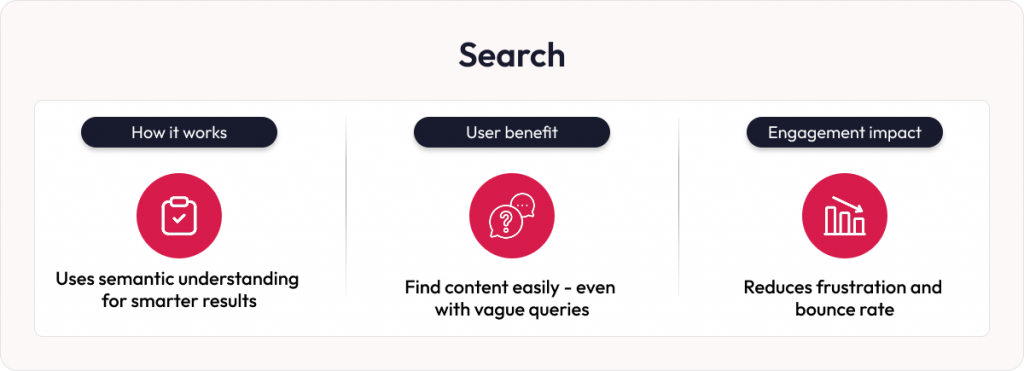
Engaging audiences with AI quizzes
Value for users: AI quizzes transform news consumption from a passive activity into an interactive and engaging experience. They provide a fun way for users to test their knowledge of current events, reinforce their understanding of key information, and identify areas where they need to learn more. This active engagement can lead to better information retention and a more enjoyable way to stay informed.
Impact on platform engagement: Quizzes offer a unique and compelling way to attract and retain users. They can increase time spent on the platform as users participate in the quizzes and review their results. Quizzes are also highly shareable on social media, which can drive additional traffic to the platform. By making news consumption more interactive and fun, quizzes can foster a stronger connection with users and encourage them to return for more engaging content.
How AI works: AI can generate engaging and relevant quizzes related to news stories. NLP can analyze articles to identify key facts and concepts that can be turned into quiz questions. AI algorithms can also personalize the difficulty and content of quizzes based on a user’s past performance and areas of interest. Furthermore, AI can provide instant feedback and explanations for answers, enhancing the learning experience through next-generation OTT innovations.

Navigating the challenges of AI in news platforms
As we harness AI to redefine news engagement, we must also confront the challenges and ethical considerations that accompany this transformative journey. While AI-powered features promise unparalleled efficiency and personalization, they introduce complexities that demand careful stewardship to preserve trust and journalistic integrity, supported by robust AI-driven software development and AI-enhanced testing.
- Mitigating misinformation and bias: AI systems, such as summarization and recommendation engines, rely on algorithms that can inadvertently amplify biases in training data or oversimplify nuanced stories, potentially leading to misinformation. For instance, abstractive summarization may misinterpret context, while personalization algorithms risk creating echo chambers by prioritizing content that reinforces existing user beliefs. To address this, platforms must implement robust validation mechanisms, incorporate diverse datasets, and ensure editorial oversight to maintain accuracy and balance.
- Safeguarding user privacy: Personalization and recommendation systems thrive on user data, raising significant privacy concerns. Collecting browsing histories, interaction patterns, and demographic details requires transparent data practices and stringent security measures. Platforms must empower users with clear consent options and granular control over their data, fostering trust while complying with global regulations like GDPR and CCPA.
- Preserving editorial independence: Reliance on AI infrastructure from tech giants for features like enhanced search and translation can erode news platforms’ autonomy. Overdependence may shift control over content prioritization or visibility, subtly influencing editorial decisions. News organizations should invest in proprietary AI solutions or form strategic partnerships, prioritizing journalistic values to counter this.
- Ensuring equitable access: AI-driven features, while innovative, risk exacerbating the digital divide. Users in underserved regions or limited access to advanced technology may be excluded from personalized or interactive experiences. Platforms must strive for inclusivity by optimizing AI tools for low-bandwidth environments and offering multilingual support to ensure global accessibility.
- Balancing engagement with depth: While engaging, interactive features like quizzes and chatbots could inadvertently trivialize serious news or prioritize entertainment over substance. Platforms must design these tools to encourage meaningful learning and critical thinking, ensuring they complement rather than overshadow in-depth reporting.
By proactively addressing these challenges, news platforms can responsibly harness AI’s potential. Ethical AI implementation requires transparency, continuous bias monitoring, and an unwavering focus on user trust. As we chart this new era, balancing innovation with accountability will be paramount to creating new experiences that are not only engaging but also equitable and trustworthy.
Redefining news with AI in news platforms
AI in news platforms reshapes how audiences consume and engage with information, delivering tailored, efficient, and interactive experiences. Features like summarization, translation, personalization, recommendations, chatbots, search, and quizzes address user needs while driving engagement and loyalty. Yet, ethical considerations—mitigating bias, ensuring privacy, and preserving editorial integrity—remain critical to sustaining trust. As AI in news platforms continues to evolve, embracing these intelligent features with accountability will create indispensable platforms that inform, captivate, and connect users in an ever-changing digital landscape.
Connect with Robosoft Technologies to craft an AI-powered digital news platform, leveraging our proven expertise in OTT solutions and innovative projects like deKoder.









